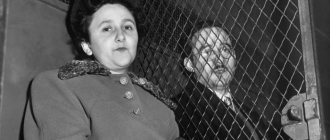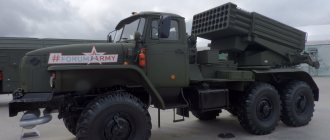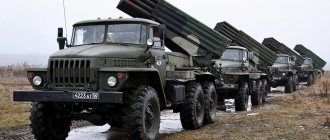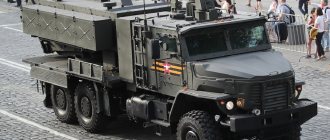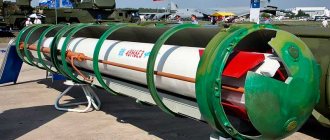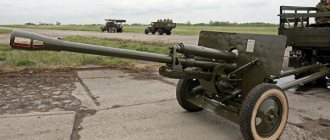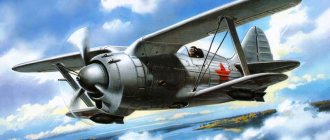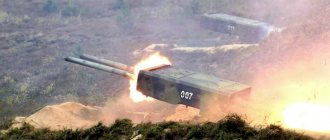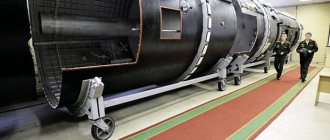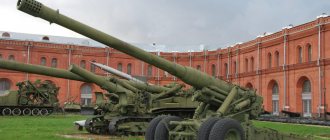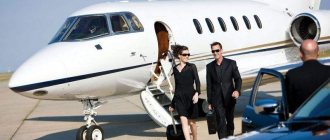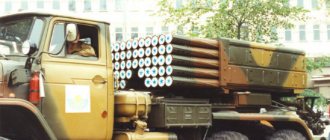BTR-80 – video
The BTR-80 entered mass production in 1984, and, having been modernized several times, is still in production as of 2012. The latest modifications of the BTR-80, equipped with enhanced weapons, are classified by many experts as wheeled infantry fighting vehicles. It was used by Soviet troops in the Afghan War, and since the 1990s it has been the main armored personnel carrier of the Armed Forces of Russia and a number of other former Soviet republics and has been used in almost all major armed conflicts in the post-Soviet space. The BTR-80 was actively supplied and exported; in total, as of 2011, the BTR-80 is in service with at least 26 states.
History of creation and production
By the early 1980s, the main armored personnel carrier of the USSR was the BTR-70, launched into mass production in 1976. The experience of their operation soon showed that, despite considerable improvements compared to the earlier BTR-60, most of the main disadvantages of its predecessor were transferred to it almost unchanged. One of them was the relatively complex and unreliable design of the power plant consisting of twin carburetor engines, which were also characterized by increased fuel consumption and a number of other disadvantages compared to a diesel engine. An equally serious problem remained the unsatisfactory disembarkation and landing of troops and crew, which only slightly improved compared to the BTR-60. As the Afghan War showed, the vehicle’s security also remained unsatisfactory. Added to all this on the BTR-70 were problems with the new design of the water-jet propulsion unit, which often became clogged with algae, peat slurry and the like while afloat.
To correct these shortcomings, the GAZ-5903 armored personnel carrier was designed in the design bureau of the Gorky Automobile Plant under the leadership of I. Mukhin and E. Murashkin in the early 1980s. While maintaining the same layout of the BTR-70, the new vehicle differed from it in a number of changes. Instead of a pair of carburetor engines, one diesel engine of higher power was installed, and large double hatches were installed in the sides of the hull for boarding and disembarking the crew. The body itself has become 115 mm taller and longer, and 100 mm wider, although the overall height of the car has increased only by 30 mm. The desire to provide the crew with the ability to fire from under the protection of the armor was further developed, for which the shooting ports on the sides of the hull were replaced by ball mounts turned towards the front hemisphere. The armored personnel carrier's armor was strengthened only slightly, but even so, the weight of the GAZ-5903 increased by 18% compared to the BTR-70, from 11.5 to 13.6 tons, although the mobility of the vehicle generally remained unchanged, and the cruising range only increased. After successful state tests, the GAZ-5903 was adopted by the Soviet Army in 1986 under the designation BTR-80.
Design
The BTR-80 has a layout with the control compartment located in the front, the combined landing and combat compartment in the middle, and the engine-transmission compartment in the rear of the vehicle. The regular crew of the BTR-80 consists of three people: a squad (vehicle) commander, a driver and a gunner; in addition to them, the armored personnel carrier can transport seven troops inside, in the airborne compartment, and the same number outside, on the armor.
Armored hull and turret
The BTR-80 has poorly differentiated bulletproof armor protection. The armored body of the conveyor is assembled by welding from rolled sheets of homogeneous armor steel with a thickness of 5 to 9 mm. Most of the vertical armor plates of the BTR-80, with the exception of the lower side and stern ones, are installed with significant angles of inclination. The armored hull of all BTR-80s has a streamlined shape, which increases its seaworthiness and is equipped with a folding wave-reflective shield that fits in the stowed position on the middle frontal plate of the hull, thus slightly increasing its protection.
In the frontal part of the hull there is a control compartment, in which, on the left and right, respectively, are the driver and commander of the armored personnel carrier. Behind it is a landing squad, combined with a combat one. Six paratroopers in the aft part of the troop compartment are located in it on two longitudinal plastic seats in the center, sitting facing the side. In the front part, immediately behind the driver’s and commander’s seats, there are two single seats for the remaining members of the landing party, with the right seat facing the direction of the vehicle to ensure the possibility of firing, and the left seat, occupied by a member of the landing party, who in combat conditions becomes a turret gunner , turned with his back to the board. Near the seats of all members of the landing force, except for the turret gunner, there are eight ball mounts on the sides with horizontal aiming angles from ±15 to ±25° for firing from personal weapons. The ball installations are deployed in the direction of the front hemisphere, as a result of which the rear hemisphere is a dead zone for paratroopers; there is also a small dead zone in the front left. Also, two more hatches for shelling the upper hemisphere, without ball installations, are available in the landing hatches in the roof.
The BTR-80, like its predecessors, has two rectangular landing hatches in the roof, but the main means of disembarkation and landing on it are large double-leaf side doors located immediately behind the turret. The top lid of the side door folds forward as the vehicle moves, and the bottom one opens down, becoming a step, which, unlike its predecessors, allowed troops to board and disembark from the BTR-80 on the move. The driver and commander, as on previous models of armored personnel carriers, have two individual semicircular hatches above their workplaces. In addition, the BTR-80 hull has a number of hatches and hatches that served for access to the engine, transmission and winch units.
Armament
The BTR-80 is armed with a twin mount of a 14.5 mm KPVT machine gun and a 7.62 mm PKT. The installation is placed on trunnions in the frontal part of the turret, its guidance in the vertical plane, within the range of −4...+60°, is carried out manually using a screw mechanism, horizontal guidance is carried out by rotating the turret. The machine guns were aimed at the target using a 1PZ-2 periscopic monocular optical sight, which had a variable magnification of 1.2× or 4× with a field of view of 49° and 14°, respectively, and provided fire from the KPVT at a range of up to 2000 meters at ground targets and 1000 m against air targets, and from the PCT - up to 1500 meters against ground targets. The KPVT is designed to combat lightly armored and unarmored enemy vehicles, including low-flying air targets, and has an ammunition load of 500 rounds in 10 belts, equipped with B-32 armor-piercing incendiary bullets, armor-piercing tracer BZT, armor-piercing incendiary bullets with a tungsten carbide core, BST , incendiary ZP and incendiary instant action MDZ. The PKT is designed to destroy enemy personnel and firepower and has an ammunition load of 2000 rounds of ammunition in 8 belts.
Surveillance and communications equipment
During the daytime, in non-combat conditions, the driver and commander of the BTR-80 monitor the terrain through two hatches in the upper frontal armor plate of the hull, closed by windshields. In combat conditions or when moving at night, they monitored the terrain through periscope viewing devices of various types. The driver on early production vehicles had three TNPO-115 periscope viewing devices for viewing the front sector; on subsequent series vehicles, another TNPO-115 was added to them in the upper left zygomatic armor plate of the hull. In night conditions, the central forward-facing device was replaced by a TVNE-4B periscopic binocular passive night vision device, which worked by enhancing natural light, or by illuminating it with an FG125 headlight with an infrared filter. The field of view of the device along the horizon was 36°, vertically - 33°, and the viewing range under normal conditions was 60 meters when illuminated by a headlight and 120 with natural illumination of 5·10−3 lux.
The main means of observation for the vehicle commander is the TKN-3 combined binocular periscope electro-optical viewing device with day and passive night channels. TKN-3 had a magnification of 5× for the day channel and 4.2× for the night channel, with a field of view of 10° and 8°, respectively. The installation of the device allowed it to rotate within ±50° horizontally and swing within −13 to +33° in the vertical plane. The device was connected to an OU-3GA2M spotlight with a removable infrared filter, which served for illumination in conditions of insufficient natural light. The night vision range for the TKN-3 was 300-400 meters. In addition to the TKN-3, the commander has three TNPO-115 devices - two for viewing the front sector and one installed in the right upper zygomatic armor plate.
For a turret gunner, the main means of observing the terrain is the gun sight; in addition, he has periscopic viewing devices: TNP-205, located on the left side of the turret and TNPT-1, installed in the roof of the turret and providing rear visibility. The landing force had two TNP-165A periscope viewing devices installed in the hull roof behind the turret, at the machine gunners' seats, as well as four TNPO-115 devices installed in the upper side armor plates of the hull on both sides of the doors.
For external communications, the R-123M radio station was installed on the BTR-80 of early releases, which was replaced by the more modern R-163 or R-173 on vehicles of later releases. For internal communications, the BTR-80 is equipped with a tank intercom R-124 for three subscribers - the commander, driver and turret gunner.
Engine and transmission
The BTR-80 uses a KamAZ-7403 engine with a turbocharger installed in the engine camber. The BTR-80 with the YaMZ-238M2 engine has the index BTR-80M.
Modifications
Soviet and Russian
– BTR-80 - basic modification with weapons from a 14.5 mm KPVT machine gun and a 7.62 mm PKT
– BTR-80K - command version of the BTR-80, with weapons retained and additional communications and headquarters equipment
– BTR-80A - a modification with weapons from a 30-mm 2A72 automatic cannon and a 7.62-mm PKT machine gun, installed in a new monitor-mounted turret. Many experts classify it as a wheeled infantry fighting vehicle.
– BTR-80S - a variant of the BTR-80A for the Russian National Guard troops, equipped with a 14.5 mm KPVT machine gun and a 7.62 mm PKT in a monitor-mounted turret
– BTR-80M is a variant of the BTR-80A with a YaMZ-238 engine (240 hp) and KI-126 tires with increased bullet resistance. It differs from its predecessors in the increased body length.
Hungarian
In Hungary, the CURRUS company, based on the BTR-80, developed a family of special vehicles with the installation of various additional equipment, taking into account NATO requirements:
– BTR-80 SKJ – armored medical vehicle – BTR-80 VSF – radio-biochemical reconnaissance vehicle – BTR-80 MVJ – repair and recovery vehicle – BTR-80 MPAEJ – maintenance and repair vehicle – BTR-80 MPFJ – engineering vehicle
Ukrainian
– BTR-80-KBA-2 - Ukrainian modernization of the BTR-80 (the BTR-80 turret was dismantled, a combat module with a 30-mm KBA-2 automatic cannon and a device for shooting smoke grenades was installed instead) – BTR-80UM - Ukrainian modernization of the armored personnel carrier -80. A Ukrainian engine produced in Tokmak with a capacity of 300 horsepower and a new turret with machine gun and cannon armament (23 mm automatic cannon and 7.62 mm machine gun) were installed. The first demonstration model of the BTR-80UM was presented at an exercise in September 1998 - BTR-80UP - a Ukrainian-Polish modernization of the BTR-80, developed for Iraq. Protection has been strengthened, new diesel engines with a capacity of 300 hp have been installed. p., new tires and new electrical and pneumatic systems, the water jet installation was removed. In addition to the linear armored personnel carrier, 7 specialized modifications have been developed
Steering and braking system of the armored personnel carrier."
1. Drive for controlling the rotation and stopping brakes of infantry fighting vehicles, steering and braking system of armored personnel carriers.
The BMP rotation control drive is designed to rotate the vehicle.
The BMP stopping brake control drive is designed to brake the vehicle.
The BMP parking brake drive is designed to brake the vehicle when parked on a horizontal section, on descents and ascents, and to slow down the vehicle when towing it on land.
The steering of the armored personnel carrier is designed to ensure the movement of the vehicle in a given direction.
The vehicle is controlled when driving on land by turning the wheels of the two front axles, and when afloat - by simultaneously turning the wheels, water rudders and steering unit flaps.
Brake systems of armored personnel carriers are designed to reduce the speed of movement and to completely stop the vehicle, as well as to keep the vehicle from rolling away. The machine has a service brake system that acts on all eight wheels, a parking brake system that acts on the transmission, and an anti-roll device that locks the transmission and prevents the machine from rolling when stopped on an incline.
2. Technical characteristics, design and operation of the BMP rotation control drive.
Control drive for planetary rotation mechanisms
PMP control drives include:
— machine rotation control drive;
— drive for switching on slow gear.
The machine rotation control drive (see figure) is designed to rotate the machine with different radii.
The steering drive includes:
- steering wheel;
— roller with levers;
— connecting rods;
- rotation spools.
The steering wheel is made in the form of two horizontal levers and is mounted on the splines of the shaft. There is a horn button in the middle of the steering wheel.
The roller is installed in bushings in the steering column tube. In the middle part, a stop is fixed to the roller, and a strip is welded to the column pipe, into which adjustable limiting bolts are screwed. The stop and bar limit the angle of rotation of the steering wheel (prevent impacts of the spool valves on the spool housing body). There are two levers installed on the roller, which are mounted on the roller with their hubs and can rotate relative to it. The hubs have longitudinal grooves, and two pins are pressed into the shaft and fit into the grooves. When you turn the steering wheel, one of the pins rests against the edge of the hub groove and turns the lever together with the shaft. At this time, the second pin slides along the groove in the hub of the other lever and does not affect the lever.
Rice. Steering drive:
1 — spool box; 2 — drive rod of the left PMP; 3 — slow-shift engagement rod; 4 — spool lever for turning the left PMP; 5 — lever return spring; 6 — pipeline for supplying oil to the booster of the right stopping brake; 7 — oil supply pipeline to the left parking brake booster; 8 — return spring; 9 — lever for driving the spool of the stopping brakes; 10 — lever for the rotation spool of the right PMP; 11 — drive rod for controlling the right PMP; 12 — slow-shift engagement rod; 13 — partition of the power compartment; 14 — control column mounting bracket; 15 — protective cover; 16 — fork for engaging slow gear; 17 — gear shift lever; 18 — steering wheel (steering wheel); 19 — lever for engaging slow gear; 20 — movable stop of the steering shaft; 21 — bolt-limiter for turning the steering wheel to the left; 22 — bolt-limiter for turning the steering wheel to the right; 23 — control lever for the right PMP; 24 — control lever for the left PMP; 25 — steering shaft; 26 — roller of the slow gear lever; 27 - levers.
The rotation spools serve to connect the hydraulic cylinders BF and DT PMP with the pressure and drain lines of the hydraulic control system. Installed in horizontal drillings of the spool box (lower spools). There are two rotation spools:
— spool for turning the left PMP;
— right PMP rotation spool.
The spool is a cylindrical rod with grooves, which is pivotally connected to the spool lever. The lever has two ball pins for connecting rods. Turning the lever causes the spool to move. The spool returns to its original position under the action of the return spring.
Connecting rods connect the shaft levers to the spool levers.
Drive operation
When the steering wheel is turned, the roller rotates, and one of the levers moves the spool through the connecting rod. The spool, moving, opens in a certain sequence the channels for supplying oil to the hydraulic cylinders of one of the PMP (or drain channels), ensuring the operation of the PMP in one of the modes. The car is turning. The turning radius depends on the steering angle.
The drive for switching on the slow gear (see figure) is designed for a short-term increase in traction on the drive wheels without changing gears (turning off the BF, turning on the DT in both PMPs).
The deceleration drive includes:
— power lever;
— roller with levers;
— connecting rods;
- rotation spools.
The power lever is installed to the left of the steering column. The lever moves in a vertical slot in the comb. To fix the lever in the lower position (with slow gear engaged), the slot has a horizontal protrusion. The lever is pivotally connected to the roller. This connection allows the roller to rotate when the lever moves vertically in the comb slot. The roller is installed on the steering column in bushings. Two levers are welded to the roller. The levers are pivotally connected by connecting rods to the levers of the rotation spools (with the outer ball pins of the levers). The rotation spools are considered in the rotation control drive.
Drive operation
To engage slow gear, the engagement lever must be moved down and secured in the horizontal slot of the comb. At the same time, the roller with levers rotates, which, through connecting rods and spool levers, simultaneously move both rotation spools in the spool box.
The spools move to a position that opens the passage of oil into the hydraulic cylinders of the BF and DT (turning off the BF and turning on the DT) of both PMPs. Both PMPs operate in a mode that increases the gear ratio by 1.44 times, respectively, and the torque on the drive wheels increases by 1.44 times, but the speed of the vehicle decreases.
Performance characteristics of the BTR-80
Crew, people: 3 Troops, people: 7 Years of operation: from 1986 to present
Weight of BTR-80
– 13.6 tons
Dimensions of BTR-80
– Body length, mm: 7650 – Body width, mm: 2900 – Height, mm: 2350..2460 – Base, mm: 4400 – Track, mm: 2410 – Ground clearance, mm: 475
BTR-80 armor
– Armor type: rolled steel – Hull front, mm/deg.: 10 – Hull side, mm/deg.: 7..9 – Hull rear, mm/deg.: 7 – Turret forehead, mm/deg.: 7 – Tower side, mm/deg.: 7 – Cabin stern, mm/deg.: 7
Armament of the BTR-80
– Firing range, km: 1..2 (KPVT); 1.5 (PKT) – Sights: 1PZ-2 – Machine guns: 1 × 14.5 mm KPVT; 1 × 7.62 mm PKT
Engine BTR-80
– Engine type: KamAZ 7403 – Engine power, l. p.: 260
Speed BTR-80
– Speed on the highway, km/h: 80 – Speed on rough terrain, km/h: 20..40 on the ground; 9 afloat – Cruising range on the highway, km: 600 – Cruising range over rough terrain, km: 200..500 on dirt roads – Specific power, l. s./t: 19.1
– Wheel formula: 8 × 8 / 4 – Suspension type: individual torsion bar with hydraulic shock absorbers – Climbability, deg.: 30 – Crossable wall, m: 0.5 – Crossable ditch, m: 2 – Crossable ford, m: floating
How to drain water from BTR 80
Description of the armored personnel carrier
Armored Corps
Armament
Observation devices
Special equipment
Power point
Carburetor operation further
useful links
Coolant drain
To drain the coolant:
— unscrew the plug in the bottom of the housing under the boiler drain hose of the starting heater;
— open the hatch covers above the power plant compartment;
— remove the plugs from the expansion tanks , open two taps and three shut-off valves of the heaters;
— place the dishes under the six drain holes in the bottom of the machine body. the coolant into a clean metal container and store it for later refilling;
— open eight taps : two on the heat exchangers, one at the starting heater boiler and five at the heaters.
After pouring the coolant from the expansion tanks into the system, open the filler caps of the cooling systems.
After the coolant has completely drained, close the drain valves and replace the filler caps and expansion tanks.
Close the drain valves according to the instructions on the instruction plates (the instruction plate indicating how to drain the coolant from the front heater is located to the left of the driver on the wheel well, about draining the rear heaters - on the right transverse casing of the rear heaters, about draining the heater, right and left heat exchangers - on the hatch cover of the central partition of the power unit compartment).
If the taps are poorly closed or leaky, water will leak and, at low ambient temperatures, may freeze in the outlet hose. In such cases, clean the hose before draining the water through the hole in the bottom.
If leaks through the drain valve, disassemble it, descale it and lubricate it with lubricant 1-13 or Litol-24.
If during summer operation of the machine the cooling system for some reason was filled with water without a three-component additive, then when switching to winter operation it must be flushed.
Flushing includes draining the water, filling the cooling system with clean water with a three-component additive, starting and warming up the engines to a temperature of 80-90°C (when the heating system is turned on) and completely draining the flushing liquid 2 hours after stopping the engines.
